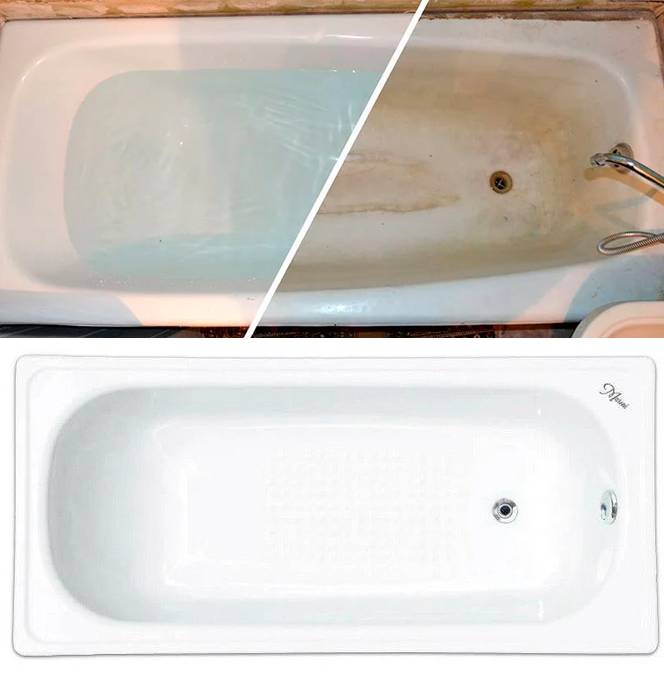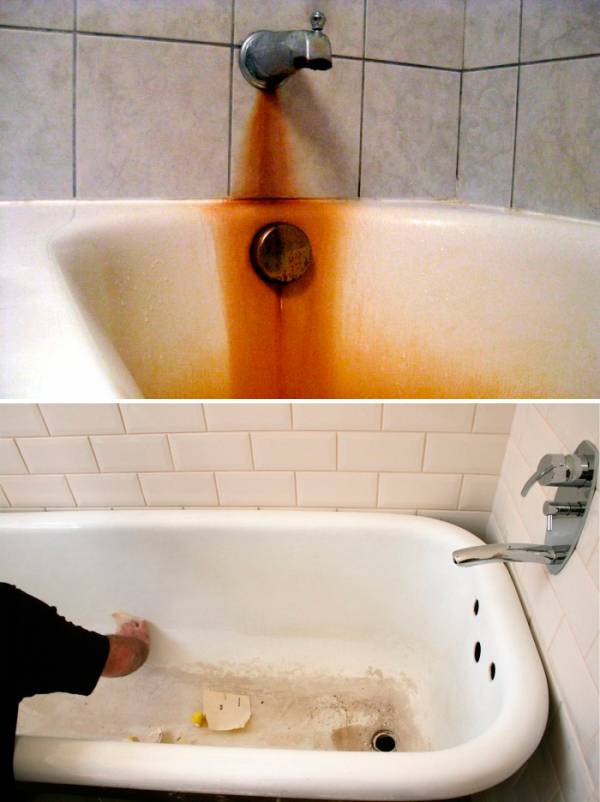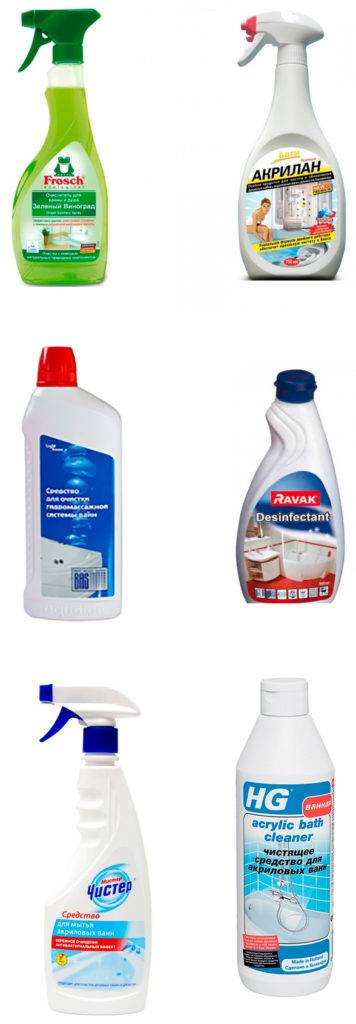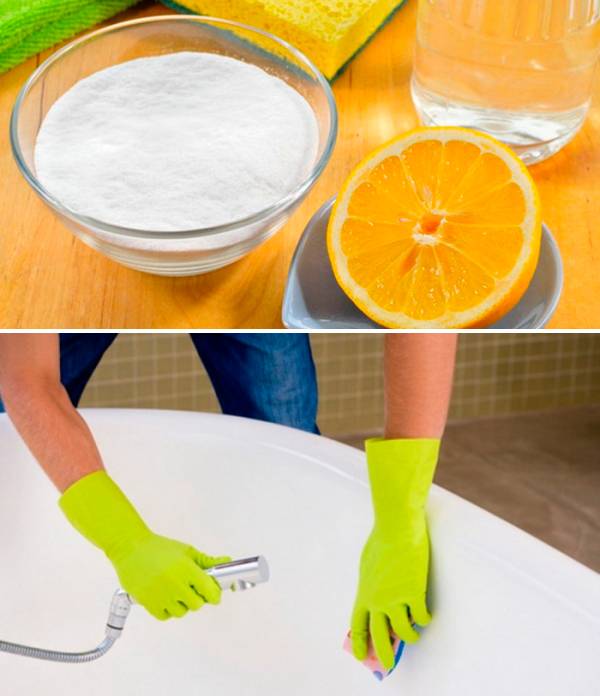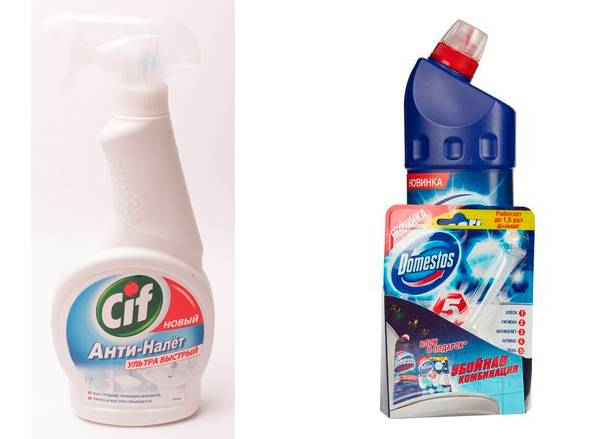A snow-white bathroom is the dream of many housewives. I'll show you how to get it done without spending a lot of time and effort. In most cases, the bath itself becomes the object of increased attention. Any plumbing can suffer from rust, yellowness, limescale and ingrained dirt if not properly maintained. The material of manufacture does not really matter.
The reasons for the appearance of dirt on the bath and their nature
To quickly and effectively get rid of the problem, you need to understand the reasons that provoked it. The list is quite extensive, it includes:
- interaction with water;
- high humidity;
- sudden changes in temperature;
- residues of detergents and cleaning agents;
- malfunctions of plumbing equipment.
You must not forget that the bath should only be used for its intended purpose. Regular violation of this rule is fraught with the appearance of blockages and destruction of the protective layer.
Soap bloom is the result of the use of gels, shampoos and other detergents. Contrary to popular belief, completely removing the film by simply rinsing the bathtub is unlikely to work. Over time, it eats into the surface of the product more and more, negatively affecting its appearance. In this case, you cannot do without special means.
Limescale is a sign that your tap water is too hard. Yellow spots are caused by leaks, and rust is caused by high iron content. Mold and mildew can be found between the tiles and the bathroom.
Features of cleaning and chemicals for baths from various materials
Acrylic does not tolerate aggressive chemicals. When cleaning, it is not recommended to use products containing ammonia, alcohol and acids. Washing powder is also prohibited, otherwise the coating will turn yellow and lose its shine.
The best way out of the situation will be the purchase of special products, among them are: Akrilan, Frosch "green grapes", Tim Profi, Domestos without chlorine, ОС, CillitBang, Pemolux, Chister, Ravak Desifenctant, HG.
If you have a bathtub with hydromassage, the following products will help you to clean it: BAS, MELLERUD.
They can be replaced with dish soap and liquid soap. To prolong the life of the bathtub, it should be regularly treated with wax polish. I do not recommend cleaning your acrylic with a brush or hard cloth. Damage resulting from such cleaning is almost impossible to get rid of.
Enamel is characterized by higher wear resistance. If you clean it regularly, the bathtub will retain its presentable appearance for a long time. Detergents should be free of chlorine and acids. The iron brush, abrasives, dry powders will have to be abandoned. This is due to the thinness of the top layer. The list of special formulations includes gels from the San Wedge, Comet, Sanox, Cif, Mister Muscle series.
For modern cast-iron bathtubs, the care is the same as for enameled ones. Yellow spots form on the surface of old containers after contact with water, which cannot be avoided in the bathroom. You can get rid of them by using table vinegar, a mixture of liquid soap and baking soda, and ammonia.
Cast marble is also afraid of abrasives, aggressive detergents and mechanical stress. To make it easier to care for the product, manufacturers have launched safe formulations such as HG, MELLERUD, Akemi and VEGA on the market.
Folk remedies for washing the bath
You can use them if there is no desire or time to buy ready-made formulations.
When using home-made mixtures, one should not neglect devices whose function is to protect the skin, mucous membranes and respiratory tract. These include rubber gloves and a mask. The room must be equipped with a ventilation system.
| Composition | Preparation and use | What baths and pollution cleans |
| Vinegar Soda |
Soda is applied to a damp surface in a thin layer and left for 15 minutes. Mix the bleach and vinegar in equal proportions. A second layer is made from the finished composition. After 40 minutes, wash the bath. |
Thus, you can get rid of limescale, yellow deposits. The method is suitable for cleaning enamel and cast iron baths. |
| Citric acid (1 sachet) | Dissolve in a glass of warm water. Wipe the surface with the resulting product. Wash off after half an hour with cool water. | For all types of plumbing. Fast and effective removal of rust and yellow deposits. |
| Wine stones (5 g) Hydrogen peroxide (70 ml) Cleaning powder (300 g) |
Connect all the components. Apply the paste to the damaged areas. After 10-15 minutes, wash it off with running water. |
For enamelled baths only. |
| Hydrogen peroxide Ammonia |
Mix the components in a 1: 2 ratio, respectively. The surface is treated with a solution, rinsed with warm water. The procedure is repeated if necessary. | This tool can clean not only plumbing, but also tiles. |
| Washing powder Food soda (2.5 tbsp. l.) Hydrogen peroxide (50 ml) |
The ingredients are dissolved in 1 glass of hot water. Wipe the bath with a sponge dipped in the composition. Wash off the product after 30 minutes. |
Suitable for all surfaces. Eliminates various types of contamination. |
| Laundry soap Soda ash |
Soap, crushed on a grater, and soda are poured into a small container. They are taken in equal shares. To make the mixture wet, add water to it. The composition should remain on the stains for an hour. To enhance the effect, rub the affected areas with a sponge. Then they just rinse the bath. | |
| Hydrogen peroxide (50 ml) Trisodium phosphate (4 tbsp. L.) |
Dissolve trisodium phosphate. You will need 3 liters of liquid. Pour in hydrogen peroxide. Cleanse dirt with a sponge. The remaining spots are “soaked” for 10-15 minutes. The solution is washed off with running water. |
Using this method, you can remove rust from cast iron and metal products. |
| Oxalic acid | A solution is made from the main ingredient and water (1:10, respectively). The agent is left on the surface of the bath for an hour. | Suitable for processing rust-damaged acrylic products. |
| Vinegar (100 ml) Table salt (1 tbsp. L.) |
Mix the components in a small container. The composition is heated to 60 degrees. Keep it on the affected area for 20 minutes. Wash off with running water. |
Removing stubborn rust stains from an enamel bath. |
Features of the removal of certain contaminants
It all starts with preparation. The result depends on how well it will be carried out. Personally, it was difficult for me to decide on a detergent. The vast assortment that is presented today in household chemicals stores has become a factor that significantly complicates the task. Therefore, based on my experience, I can give some useful advice.
Before going to the store, go to the bathroom and really assess the situation. To solve the problem, you will need such initial data as:
- the material from which the bathroom is made;
- type and age of stains.
In the presence of contaminants of different origins, preference should be given to universal formulations: Cif, Domestos without chlorine.
The bathtub must be washed after each use. Cleaning several times a month must be carried out using professional products. In this case, one should be guided by the instructions for use that are attached to them.
If the spots do appear, you need not only to take measures to eliminate them, but also to neutralize the cause. Otherwise, the problem will become "chronic". How to deal with the most common contamination at home is indicated in the table.
| Spot type | Variants |
| Grease and soap deposits | A thick slurry made from baking soda. |
| Yellow smudges | Fresh lemon juice. A mixture of baking soda and soda ash. Dry bleach mixed with water. This method is not suitable for cleaning acrylics. |
| Limescale | A mixture of baking soda and lemon juice. |
| Mold | For processing, it is allowed to use ammonia, vinegar, borax and hydrogen peroxide. A composition of whiteness and activated carbon gives a good effect. |
How to wash a bath from potassium permanganate and brilliant green
I am sure that these medicines are in every home. The only disadvantage among their many advantages is the persistent coloring effect. When brilliant green and potassium permanganate get into the plumbing equipment, characteristic spots are formed, which are quite difficult to get rid of.
Potassium permanganate can be washed off with a mixture of lemon juice (or acid) and hydrogen peroxide.
Traces of brilliant green are removed with alcohol. This method will not have the desired effect if the bathtub is made of acrylic. But there is no need to be upset, over time the pollution will disappear by itself.
How to clean a bathtub after renovation
To prevent the appearance of stains and damage to the protective layer, I always cover the bath before starting work. If the problem cannot be avoided, an ambulance will be required. The cleaning agent should be selected based on the cause of the contamination.
Aggressive solvents can be used to remove silicone, paint and grout. These include solvent, white spirit, acetone and gasoline. Lime mortars are removed using special products, for example, Duty Extra. It should be borne in mind that such processing will negatively affect the condition of the acrylic and enamel coatings. The sooner the cleansing is carried out, the better the result.
The sealant is designed for more reliable fixation of seams and joints. To remove it from the surface of the bath, you should purchase professional formulations. In the absence of such an opportunity, you can use folk remedies. They should contain table salt.
How to clean an old bathtub
Products that have been in use for a long period often have an unassuming look. Stains and defects formed on the coating can be removed without the help of specialists. Of course, a lot depends on the area of the lesion, the characteristics of the material and the complexity of the problem.
Lime deposits, which have eaten deep into the surface, are washed off with a solution of ammonia, a mixture of salt and vinegar, and lemon juice. Rust and drips are removed with turpentine. At the last stage, a dishwashing gel is used. Unfortunately, folk methods will not be able to get rid of microcracks. In this case, only restoration will help, which can be compared in cost to the purchase of a new bath.
Features of cleaning chrome surfaces
Faucets and shower hoses are also susceptible to rust and limescale. To solve the problem, you can use tooth powder, baking soda and table vinegar. These components are applied to the chrome surface with a sponge or soft cloth.
Prevention is the best solution anyway. Knowing how to clean your bathtub at home will help you avoid most problems.

